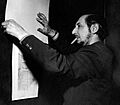Carlo Scarpa facts for kids
Carlo Scarpa (born June 2, 1906 – died November 28, 1978) was a very talented Italian architect. He was inspired by the materials, landscapes, and rich history of Venice, Italy, and also by the culture of Japan. Scarpa used his love for history, local traditions, new ideas, and the skills of artists and craftspeople to create amazing designs for buildings, glass, and furniture.
Carlo Scarpa's Life Story
Carlo Scarpa was born in Venice, a famous city in Italy. When he was two years old, his family moved to Vicenza. Later, when he was 13, his mother passed away, and he moved back to Venice with his father and brother.
In Venice, Carlo went to the Academy of Fine Arts. There, he studied architecture and learned a lot about design. After graduating, he worked with an architect named Francesco Rinaldo. Carlo later married Rinaldo's niece, Nini Lazzari.
Even though he was a brilliant architect, Carlo Scarpa chose not to take a special government exam after World War II. Because of this, he wasn't officially allowed to call himself an "architect" in Italy without working with another licensed architect. But everyone who worked with him – his clients, friends, and the people who built his designs – respected him so much that they called him "Professor." This showed how much they admired his skills and knowledge.
Scarpa's buildings show a deep understanding of how time changes things, from the seasons to history itself. He was very creative with materials. He also taught drawing and interior design at a university in Venice for many years. Most of his famous buildings are in the Veneto region of Italy, but he also designed landscapes, gardens, and buildings in other parts of Italy, and even in countries like Canada, the United States, and France.
One of his last projects was the Villa Palazzetto in Monselice. It wasn't finished when he died, but his son, Tobia, later made some changes to it. This project, along with the Brion Sanctuary, shows Scarpa's amazing talent for designing outdoor spaces and gardens.
In 1978, Carlo Scarpa was in Sendai, Japan, when he had a terrible accident. He fell down a flight of concrete stairs and sadly passed away ten days later from his injuries. He was buried in a very unique way: standing up and wrapped in linen sheets, like a medieval knight. His burial place is in a quiet corner of his own design, the L-shaped Brion Cemetery in San Vito d'Altivole, Italy.
In 1984, an Italian composer named Luigi Nono wrote a special piece of music for an orchestra in his honor, called A Carlo Scarpa, Architetto, Ai suoi infiniti possibili.
Famous Buildings by Carlo Scarpa
Here are some of the well-known buildings and projects Carlo Scarpa designed:
- Gallerie dell'Accademia, Venice, Italy
- Art Book Pavilion, Giardini di Castello, La Biennale, Venice, 1950–1952
- Palazzo Abatellis: The Gallery of Sicily, Palermo, 1953–1954
- Palazzo Ca'Foscari, Venice, Italy, 1935–1956
- Venezuelan Pavilion, La Biennale, Venice, Italy, 1954–1956
- Veritti House, Udine, Italy, 1955–1961
- Museo Canova di Possagno, Italy, 1955–1957
- Museo di Castelvecchio, Verona, Italy, 1956–1964
- Olivetti Shop, Piazza S. Marco, Venice, Italy, 1957–1958
- Fondazione Querini Stampalia, Venice, 1961–1963
- Brion Tomb and Sanctuary, at San Vito d'Altivole, Italy, 1969–1978
- Banca Popolare di Verona, Italy, 1973–1978
Images for kids
-
Carlo Scarpa, who admired Frank Lloyd Wright, looking at drawings in Venice, 1954.
-
The Museo di Castelvecchio in Verona. Photo taken by Paolo Monti in 1982.
See also
 In Spanish: Carlo Scarpa para niños
In Spanish: Carlo Scarpa para niños




